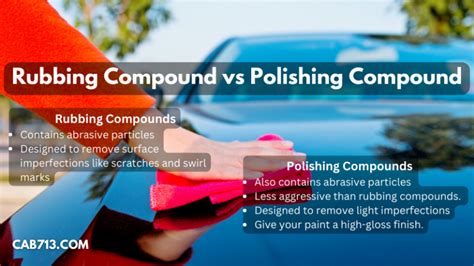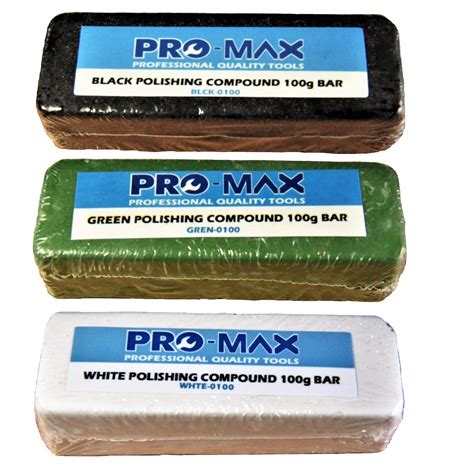The world of surface finishing is a complex and nuanced one, with a myriad of techniques and materials available to achieve the desired level of polish and protection. Among these, buffing compounds play a crucial role in the final stages of the finishing process, serving as a critical component in the pursuit of a high-luster finish. In this article, we will delve into the realm of buffing compounds, exploring their composition, applications, and the intricacies of their use in various industries.
Key Points
- Buffing compounds are used to achieve a high-luster finish on metal and other surfaces.
- They are composed of a combination of abrasives, fillers, and binders.
- The choice of buffing compound depends on the type of surface being finished and the desired level of polish.
- Buffing compounds can be used in a variety of industries, including automotive, aerospace, and jewelry manufacturing.
- Proper technique and safety precautions are essential when working with buffing compounds.
Composition and Types of Buffing Compounds

Buffing compounds are complex mixtures of abrasives, fillers, and binders, each serving a distinct purpose in the finishing process. The abrasives, which can range from coarse to fine, are responsible for removing minor imperfections and scratches from the surface. Fillers, on the other hand, help to fill in small pores and imperfections, creating a smooth surface for polishing. The binder, typically a wax or resin, holds the compound together and helps it adhere to the buffing wheel. The specific composition of a buffing compound can vary greatly, depending on the intended application and the type of surface being finished.
Abrasive Types and Their Applications
Abrasives are a critical component of buffing compounds, and their type and grit size can significantly impact the finishing process. Common abrasives include aluminum oxide, silicon carbide, and cerium oxide, each with its own unique characteristics and applications. For example, aluminum oxide is often used for polishing metals, while silicon carbide is commonly used for polishing plastics and other non-metallic surfaces. The choice of abrasive type and grit size will depend on the specific requirements of the job, including the type of surface being finished and the desired level of polish.
| Abrasive Type | Common Applications |
|---|---|
| Aluminum Oxide | Metal polishing, grinding, and cutting |
| Silicon Carbide | Polishing plastics, glass, and other non-metallic surfaces |
| Cerium Oxide | Polishing glass, ceramics, and other delicate surfaces |

Applications of Buffing Compounds

Buffing compounds are used in a wide range of industries, including automotive, aerospace, jewelry manufacturing, and more. In the automotive industry, buffing compounds are used to polish and protect metal surfaces, such as chrome and aluminum. In the aerospace industry, buffing compounds are used to polish and protect critical components, such as engine parts and landing gear. In jewelry manufacturing, buffing compounds are used to polish and finish precious metals, such as gold and silver.
Industry-Specific Considerations
When working with buffing compounds in different industries, there are several factors to consider. For example, in the automotive industry, the choice of buffing compound will depend on the type of metal being finished, as well as the desired level of polish. In the aerospace industry, the choice of buffing compound will depend on the specific requirements of the component being finished, including its material composition and operating conditions. In jewelry manufacturing, the choice of buffing compound will depend on the type of metal being finished, as well as the desired level of polish and protection.
What is the purpose of a buffing compound?
+The purpose of a buffing compound is to achieve a high-luster finish on a surface, typically metal or other materials. It is used to remove minor imperfections and scratches, and to fill in small pores and imperfections.
How do I choose the right buffing compound for my application?
+The choice of buffing compound will depend on the type of surface being finished, as well as the desired level of polish. Consider the type of abrasive, filler, and binder, as well as the specific requirements of the job, including the type of surface being finished and the desired level of polish.
What safety precautions should I take when working with buffing compounds?
+When working with buffing compounds, it's essential to take proper safety precautions, including wearing protective gear, such as gloves and safety glasses, and working in a well-ventilated area. Additionally, follow the manufacturer's instructions for use and disposal.
In conclusion, buffing compounds play a critical role in the surface finishing process, providing a high-luster finish and protection for a wide range of surfaces. By understanding the composition and applications of buffing compounds, as well as the specific considerations for different industries, users can make informed decisions about the best compound for their needs. With proper technique and safety precautions, buffing compounds can be a valuable tool in achieving the desired level of polish and protection.
Related Terms:
- Buffing Compound for cars
- Buffing Compound for Metal
- Buffing compound vs polishing compound
- Buffing compound for plastic
- Buffing compound for steel
- Buffing compound colors



